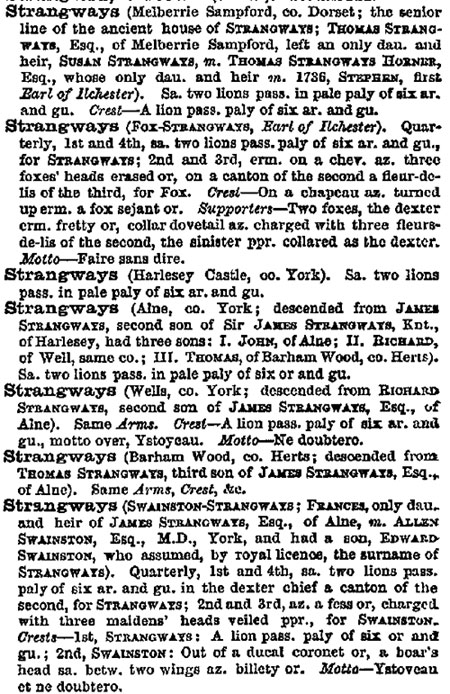The General Armory
|
These are the entries in the standard 19th reference book on British arms.
They confirm the common designs seen in the examples.
The only query is the Alne arms say “or” (ie Gold) rather than “ar” (ie Silver). Is this simply a mistake?
See below for some clues to all the weird abbreviations used in such descriptions.
|

|
|
The terms used to describe the colours in a coat of arms can vary according to source. The basic heraldic colour chart is not quite up to Pantone standards and does leave plenty of scope for interpretation -
|
Colour
|
Tincture
|
Planets
|
Precious Stones
|
Old French
|
|
Yellow
|
Or
|
Sol / Sun
|
Topaz
|
Toupace
|
|
White
|
Argent
|
Luna / Moon
|
Pearl
|
Perle
|
|
Black
|
Sable
|
Saturn
|
Diamond
|
Dyamond
|
|
Red
|
Gules
|
Mars
|
Ruby
|
Ruby
|
|
Blue
|
Azure
|
Jupiter
|
Sapphire
|
Saphir
|
|
Green
|
Vert
|
Venus
|
Emerald
|
-
|
|
Purple
|
Purpure
|
Mercury
|
Amethyst
|
Amatiste
|
|
Maroon
|
Sanguine
|
-
|
Sardonyx
|
-
|
|
Orange
|
Tawny /
Tenné
|
-
|
Jacinth
|
-
|
|
Gold
|
Or
|
-
|
-
|
-
|
|
Silver
|
Argent
|
-
|
-
|
-
|
|
The first rule of heraldry is the rule of tincture: metal must never be placed upon metal, nor colour upon colour, for the sake of contrast. So, for example, Gold / yellow should not appear on Silver / white. However as coats of arms became purely symbolic (rather than a matter of life or death in battle) this rule was not fully enforced - e.g the arms of the Vatican.
These are some commonly used terms that describe the format of a shield -
|
Name
|
Description
|
|
Bend
|
a band running diagonally
|
|
Bordure
|
a border around the edge
|
|
Canton
|
a small square located in an upper corner (normally left)
|
|
Chevron
|
an inverted V central band
|
|
Chief
|
a band across the top of a shield
|
|
Cross
|
a band running centrally top to bottom, another left to right
|
|
Fess
|
a central horizontal band
|
|
Pale
|
a central vertical band
|
|
Pile
|
a V central band
|
|
Saltire
|
a diagonal cross from corner to corner
|
|
For more detail (and accuracy) see Wikipedia...
|